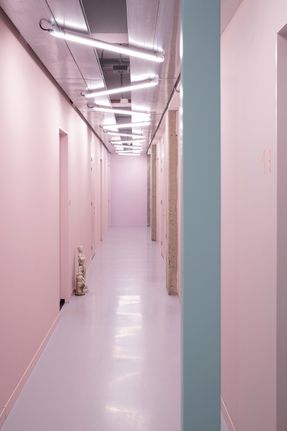
DC Van Hall
YEAR
2022
LOCATION
Amsterdam, Netherlands
TYPE
Residential › Multi Unit Housing Student Housing Hospitality + Sport › Restaurant
At the corner of Donker Curtiusstraat and Van Hallstraat in Amsterdam, we created the surprising transformation of a prominent, 1964 office building.
In the new DC Van Hall, we introduce studio housing for graduates and students, which together with creative workplaces and small-scale entrepreneurs bring new life to the surrounding Staatsliedenbuurt neighbourhood.
Designed by Ae.G. and J.D. Postma, the Westerpark Industry and Trade building added variation to the existing industrial buildings along Kostverlorenvaart, with its office function, volume and light curtain wall facades.
Since then, the U-shaped complex forms a cluster together with the Graficolor and Wodan buildings – former pre-war factories which are now both heritage-listed – that turns the building inwards from the street.
Due to the bad condition of the building from a technical and energy perspective, an extensive renovation was required.
We revived the existing concrete structure by making it visible and contrasting it with both the new facade and the soft materialisation of the interior.
The three-part building composition has been preserved, and the original canopy covering the adjacent pavements has also been recreated.
The metal, coated facade elements make a contemporary gesture, yet subtly reflect the industrial past. A green space for residents and neighbours now exists on the site of the original stony car park at the core of the volume. The restaurant at the base also has a terrace on this side. The shop windows that used to face the street have been reinterpreted with new floor-to-ceiling glass walls.
Due to the transparent plinth and open floor field on the ground floor, DC Van Hall not only connects to its surroundings, but we also allowed for a sense of lightness in the massive volume.
The shop windows that used to face the street have been reinterpreted with new floor-to-ceiling glass walls. Due to the transparent plinth and open floor field on the ground floor, DC Van Hall not only connects to its surroundings, but we also allowed for a sense of lightness in the massive volume.
With lines and patterns of tube lighting, we made the entrances and stairwell spaces recognisable both inside and outside.
The significance of DC Van Hall's new, darker facade is two-sided. The building aligns more closely now with the surrounding brick buildings in terms of mass, yet simultaneously we bring back the contrast with the brick facades that gave the building its autonomous character before the transformation.
The metal elements vary in colour under the influence of daylight, giving the building a changing presence throughout the day. The configuration of the new apartments is perceptible in the staggered rhythm of the facade elements.
The widening of the grid and windows towards the corner creates a shifted facade rhythm, providing DC Van Hall with its distinctive profile in the Staatsliedenbuurt neighbourhood.























